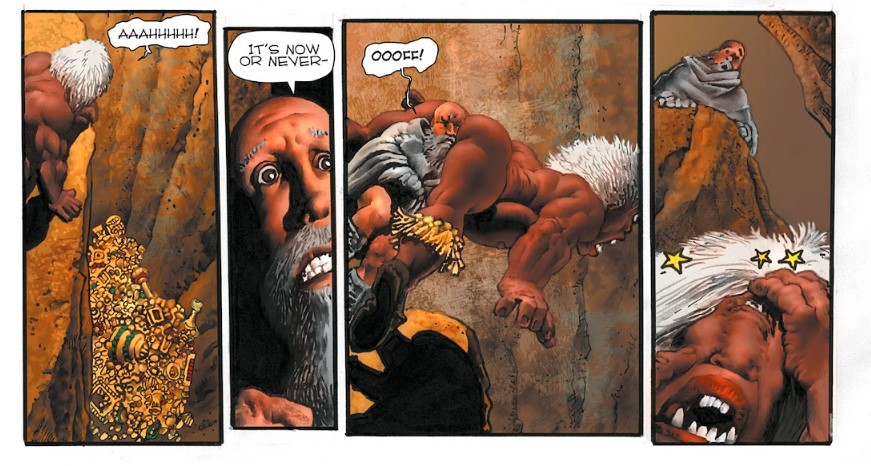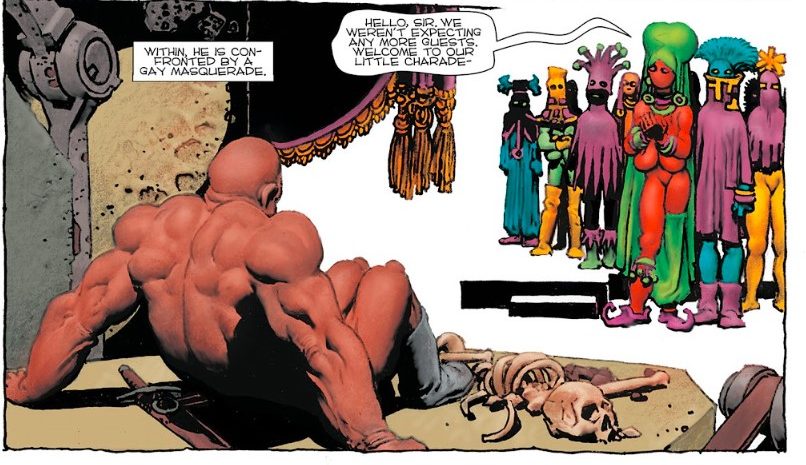On the back cover of Murky World—a hardcover collection1 of a serial that ran first in b&w through several issues of Dark Horse Presents in 2011, and then was hugely expanded in color through several more issues of the latter-day revival of Heavy Metal—some of the biggest names in comics give compliments to the story’s creator: Richard Corben. On the visual side, Moebius testifies: “Richard Corben stands among us like an extraterrestrial peak.” On the writing side, no lesser a light than Alan Moore says: “Mr. Richard Corben… a genuine giant of his chosen medium.” So anyway, in Murky World, a man launches himself head-first into the ass of a giant busty cyclops in order to push her into a pit. A scene so vital that Mr. Richard Corben does it in both the b&w and color versions, drawn slightly different each time.

I say this not as a criticism nor as an endorsement, but as a simple statement of fact. This is a representative scene for Murky World as a whole, filled as it is with boobs, butts, buff bodies, big dudes, monsters and battles. It doesn’t have much in terms of character, nor of plot. It’s probably something the kids today would call "a vibe," except the vibe in question is that of a horny 13-year old boy in the 1970s. When I read Murky World, I was sure at first that it was some early effort that had slipped my notice - but obviously that would be impossible, considering that overt smoothness of the colors and textures.2 Yet it reads so much like a young man’s comic, totally led by its id without a second thought to things like consistency.
To give an example: our lead throughout is a fellow named Tugat, who starts off as an older man (bald head, long white beard). Yet by the end of Chapter 2, Tugat has been transformed into a younger man, the adventure up to then just a dream. It's an annoying, unnecessary convolution, but maybe Corben just wanted to draw him one way and then another - just like he wanted to draw a busty cyclops, a busty older woman with an eyepatch, a busty younger woman, and a busty… everything really. Murky World is a collection of fantasy clichés taken directly from the covers of hundreds of ancient paperbacks, its story wholly untouched by the ‘self-awareness’ or ‘ironic distancing’ that so infests fantasy storytelling today (in comics and in fiction).
Tugat just sort wonders around as the story invents reasons for him to keep going: he wants revenge against a bad guy; his would-be love interest betrays him; someone steals his horse… stuff just keeps happening to this guy in order to push him from one set piece to another. And while this straightforwardness is so old-fashioned that it becomes, ironically enough, fresh again, one does not read Murky World for the story.
Corben is one these artists I hated when I first encountered him, being too young and stupid to understand what my eyes were seeing. In this, he is a proud member of the same club as Kirby and Ditko,3 the masters whose work cannot be confused with anyone else. Artists like Corben made the world of comics we inhabit today, but no one looks quite like him. Extraterrestrial peak indeed. His figure work swings wildly between realism, depicting movement and body language with meticulous exactness, to exaggerated cartooning - balloon boobs, mouths wide agape like actors delivering hammy lines. His scenery likewise seems closer to mixed media, as if Murky World is composed of a dozen different comics that have been crushed into one another.
The best pages are the ones that remind you of Corben’s horror roots: the design of various monsters, beasts, shots of old bones rotting away. One short chapter, that could almost work as a standalone story, involves Tugat happening upon a house that’s being maintained by two zombie slaves, so used to their routine that they bring their guest a cup of ‘water’ that is actually just sand from a well that has long ran dry. Seeking their master, Tugat finds naught but another corpse. Yet the zombies keep working, even though it serves nothing. There’s something truly horrifying and yet beautiful about it. The manner in which Corben draws the sand pouring into a glass before being served is so carefully controlled. So subtle in its manner, it’s almost impossible to think it came from the same exaggerated artist of just two pages before (and many pages later). And this whole beautiful short is sandwiched between would-be sexy (and sexist) escapades.
Reading the whole of Murky World, I realized that most of my exposure to Corben was as a visual interpreter of other people’s prose - be it his work as an artist on stories such as Hellboy: Makoma and The Punisher: The End, two of the best-looking ‘mainstream comics’ of the 21st century, or his various adaptations of writers like Poe and Lovecraft. This is my first proper experience to pure concentrated Corben. There’s something charming about it, but also frustrating. It’s a very meandering work, one that shows its serialized roots clearly; I’m sure it was fun to read one part at a time, just getting little glimpses of Corben’s work. But reading it all in one sitting is annoying.
Tugat is a boring lug that just gets pushed around by the narrative, the people around him aren’t any more interesting, and there’s only so many ways even someone like Corben can a draw a mostly featureless desert. But even lesser Corben, which Murky World is, is worth a look or even two. Because yes, it is awkward, and badly paced, and the scripting veers wildly between mock-fantasy speech to modern language... but every once in a while you turn a page and are reminded why Corben is so revered. Because what made him good, what made him "extraterrestrial," is also what made him bad. He never compromised himself. Any look at a Corben page is a look into the mind of Richard Corben, and it’s a Murky World inside there.
* * *
The post Murky World appeared first on The Comics Journal.




No comments:
Post a Comment